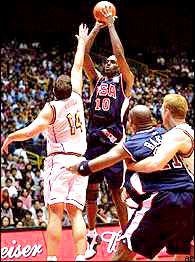


|

|
Tuesday, September 19
Americans were successful on and off court
Associated Press
SAITAMA, Japan -- Although Kevin Garnett's latest trip to
Japan wasn't perfect, he can be satisfied with this: He taught a
local kid how to slam dunk like a pro.
Giving a clinic to some of Japan's top teenage players
Wednesday during his tour with the U.S. Olympic men's basketball
team, Garnett challenged them to show off their dunking skills.
|  | | Kevin Garnett's second job as a dunk coach isn't limited to commercials. |
After a bit of prodding, a volunteer finally stepped forward
from the bashful, giggling group. A lanky, aloof teen -- the only
one on his team who didn't show up in uniform -- grabbed a ball,
loped toward the basket and leapt high into the air.
He missed.
"The kid was just being a little bit too cool," Garnett said
later. "He knew he could dunk. But there's a certain way you've
got to dunk. I had to really take him back to the foundations of
dunking."
After advising the teen to run faster on his way to the hoop, he
watched the young hipster slam the ball through, leaving the rim
shaking and a crowd of onlookers cheering.
Garnett and his teammates were in Japan this week for exhibition
games against Spain's Olympic team and the Japanese national team.
The team was scheduled to leave Thursday night for Melbourne, where
they will spent a week before traveling on to Sydney.
The U.S. team beat Spain 95-66 and Japan 105-49. They will play
the highly regarded Australian Olympic team in Melbourne on
Saturday night.
After he finished coaching the 30 or so players from Japan's
junior national teams, Garnett recalled his own early experiences
with dunking.
"The thing about dunking that I could never understand was the
timing," he said. "I could jump, but I just couldn't get my
timing right."
His first dunk came when he was 14 years old, playing a game of
21 on a friend's court.
"You gain confidence from that one dunk and you think you can
dunk on anybody and dunk at anytime," he said.
Garnett, on his third trip to Japan, conducted the clinic
despite a tight schedule and an injured left hand that was clearly
bothering him. He sat out the game against Japan and is
questionable for Saturday night's game, although the injury will
not keep him from competing in the Olympics.
Japanese officials showed their appreciation by presenting him
with a traditional doll and a carp-shaped kite 6 feet 11 inches
long -- exactly his height.
The rest of the team, meanwhile, squeezed a bit of Japanese
culture into their four-day visit.
Coach Rudy Tomjanovich spent one night dining with Japanese
friends on "chanko nabe," the traditional fare of the sumo
wrestler. The calorie-rich stew, chock-full of vegetables, meat and
tofu, is designed to help the behemoth fighters put on the pounds.
"I was really impressed," Tomjanovich said. "We enjoyed it."
And speaking of sumo wrestlers, retired Hawaiian wrestler
Konishiki was on hand for the U.S. team's win against Spain. He was
spotted heading back to the locker room with the team after the
game.
Roppongi, the center of Tokyo nightlife, was on the list of
places that some team members visited before leaving Japan.
Several also went shopping for some of Japan's famously
high-tech electronic equipment.
Ray Allen emerged from the locker room after Wednesday's game
carrying a sleek, palm-sized video camera that cost him about
$2,000 -- about half what he would have paid in the states, he
speculated.
Instead of shopping, other players were taking it easy, sleeping
off jet lag and resting up for the Olympics in the five-star hotel
where the team was staying.
Forward Vin Baker had a simple answer when asked how he spent
his free time.
"Room service," he said. "Lots of steamed rice, lots of calls
home."
|  | |
|






